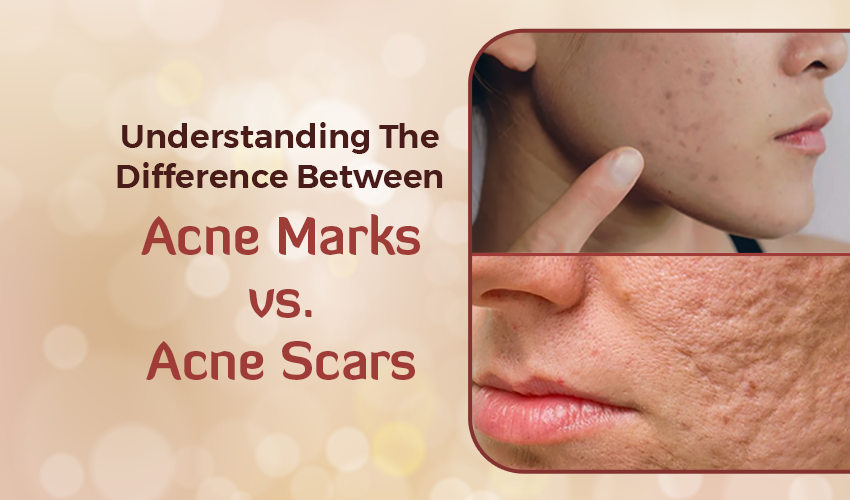Acne is a prevalent skin condition affecting millions worldwide, leaving behind not only physical blemishes but often emotional scars as well. In this comprehensive guide, we delve into the intricate world of acne marks vs acne scars, providing insights, treatments, and preventive measures to help you achieve radiant skin.
Table of Contents:
1. Understanding the difference between acne marks and acne scars
4. Causes of acne marks and acne scars
5. Treatments for acne marks and acne scars
6. Home remedies for treating acne marks and acne scars
7. Preventions
8. Myths about Acne Marks and Scars
9. The Emotional Impact of Acne Marks vs Acne Scars
10. Innovations in Skincare Technology
11. Conclusion
12. FAQ’s
Understanding the difference between acne marks and acne scars
Acne marks vs acne scars—a crucial distinction in the post-acne journey.
Acne Marks:
Acne marks are usually temporary discolorations left behind after a pimple has healed. These can be red or brown and are not considered permanent changes to the skin texture.
Acne scars:
Acne scars, on the other hand, bring more permanent changes to the skin texture. They result from the skin’s attempt to recover from a severe acne lesion, often leaving indented or raised scars.
Types of Acne Marks:
- Post-inflammatory hyperpigmentation (PIH): Post-inflammatory hyperpigmentation refers to the development of dark spots on the skin as a result of excessive production of melanin, the pigment responsible for skin color. This condition typically occurs after the skin experiences inflammation or trauma, such as acne, wounds, or other skin disorders. The increased melanin production can lead to the formation of persistent dark patches, which may vary in size and intensity.
- Post-inflammatory erythema (PIE): Post-inflammatory erythema manifests as red or purple discoloration on the skin and is caused by inflammation of blood vessels. This condition is often a consequence of various skin injuries or inflammatory conditions. Unlike hyperpigmentation, PIE involves changes in blood flow and vascular dilation, leading to the observed red or purple hues. The discoloration may fade over time, but it can be a lingering effect, especially if the initial inflammation is severe.
- Boxcar scars: Boxcar scars are a type of acne scar characterized by depressed areas on the skin with well-defined edges, resembling the pockmarks left by chickenpox. These scars typically result from the loss of collagen during the skin’s healing process after severe acne. The depressions have a box-like appearance, featuring broad and defined boundaries. Boxcar scars can vary in size and depth, contributing to the overall texture and appearance of the skin. Various dermatological treatments are available to help improve the appearance of boxcar scars, depending on their severity.
Types of Acne Scars:
- Icepick scars: These are characterized by deep and narrow pits on the skin that resemble puncture wounds. These scars often create small, concentrated indentations in the skin, giving the appearance of being pierced by an icepick.
- Rolling scars: These scars present as wavelike undulations on the surface of the skin. They give a smoother yet uneven texture, resembling the rolling hills or waves. Unlike icepick scars, rolling scars cover a larger area and create a more subtle, undulating effect.
- Hypertrophic scars: These scars are raised and thickened, forming a noticeable elevation on the skin’s surface. They are commonly observed on the chest and back. Unlike some other types of scars that result in depressions or indentations, hypertrophic scars stand out due to their raised nature, often forming a more pronounced and textured appearance.
Causes of Acne Marks and Acne Scars
Several factors contribute to the formation of acne marks and acne scars, including the level of inflammation. Post-inflammatory hyperpigmentation (PIH) is a common cause behind acne marks, caused by an overproduction of melanin in response to inflammation. Serious inflammation and damage to the deeper layers of the skin contribute to the formation of acne scars.Treatments for Acne Marks and Acne Scars
Effective treatments for acne marks vs. acne scars vary.
Treatments for Acne Marks:
- Topical Treatments:
- Vitamin C: Helps in reducing hyperpigmentation and promotes collagen production.
- Niacinamide (Vitamin B3): Fades discoloration and improves skin texture.
- Alpha Arbutin: Targets hyperpigmentation and dark spots.
- Chemical Peels:
- Glycolic Acid: Exfoliates the skin, promoting cell turnover and fading marks.
- Lactic Acid: Similar to glycolic acid but milder, suitable for sensitive skin.
- Microdermabrasion:
- Exfoliates the outer layer of the skin, improving texture and reducing marks.
- Laser Therapy:
- Intense Pulsed Light (IPL): Targets pigmentation and evens skin tone.
- Fractional Laser: Stimulates collagen production and improves skin texture.
- Retinoids:
- Prescription-strength retinoids (e.g., tretinoin): Promote cell turnover and fade marks over time.
Treatments for Acne Scars:
- Dermal Fillers:
- Hyaluronic Acid Fillers: Plump up depressed scars for a smoother appearance.
- Microneedling:
- Creates controlled micro-injuries, stimulating collagen production and improving scars.
- Laser Resurfacing:
- Fractional Laser: Penetrates deep into the skin, reducing the appearance of scars.
- CO2 Laser: Removes layers of skin, promoting collagen production.
- Chemical Peels:
- TCA (Trichloroacetic Acid) Peels: Penetrates deeper layers, improving the appearance of scars.
- Subcision:
- Breaks the fibrous bands that cause rolling scars, allowing the skin to smooth out.
- Punch Excision:
- Removes individual deep scars through a small surgical procedure.
- Silicone Gel or Sheet Therapy:
- Helps to soften and flatten raised scars.
- Platelet-Rich Plasma (PRP) Therapy:
- Uses the patient’s blood to stimulate collagen production and promote healing.
Home Remedies for Treating Acne Marks and Acne Scars
Acne Marks:
- Lemon Juice:
- Lemon juice is believed to have natural bleaching properties.
- The application of lemon juice on acne marks may assist in lightening them.
- The acidic nature of lemon juice is thought to contribute to reducing the appearance of discoloration on the skin.
- Aloe Vera:
- Aloe vera is renowned for its soothing properties and is commonly used in skincare.
- The application of aloe vera may aid in the healing process of the skin.
- Additionally, aloe vera is suggested to help reduce discoloration associated with acne marks…
Acne Scars:
- Honey Mask:
- The application of honey is proposed as a method to support the healing process of acne scars.
- Honey is believed to have properties that may contribute to minimizing the appearance of scars.
- The use of a honey mask is recommended for individuals looking to promote scar healing and reduce the visibility of acne scars.
- Coconut Oil:
- Coconut oil is suggested for its moisturizing properties, which may have a positive impact on the texture of scarred skin.
- Regular application of coconut oil to acne scars is advised with the expectation of improving the overall appearance and feel of the skin.
- The moisturizing effects of coconut oil are highlighted as a potential means to address the dryness or roughness associated with scarred skin.
Preventions
Preventing acne marks and acne scars involves a holistic approach. Adopting a proper skincare routine, avoiding picking and squeezing, practicing sun protection, and timely acne management significantly reduce the risk of lasting marks and scars.Myths about Acne Marks and Scars
Dispelling myths is crucial for informed skincare decisions. Contrary to popular belief, not all marks lead to scars, and timely intervention can significantly reduce the risk of permanent damage. Consulting a dermatologist for personalized advice is essential.The Emotional Impact of Acne Marks vs. Acne Scars
Beyond the physical aspect, acne leaves emotional imprints. Addressing the psychological toll, this section explores coping mechanisms, emotional support, and the importance of self-love throughout the skincare journey.Innovations in Skincare Technology
Stay informed about the latest developments in skincare technology at acnewiki.org. From advanced laser treatments to groundbreaking topical solutions, the future looks promising for those seeking effective ways to address acne marks vs. acne scars.Conclusion
In conclusion, navigating the realm of acne marks vs. acne scars requires understanding, patience, and a multifaceted approach to treatment. Distinguishing between the two, seeking professional advice, and adopting preventive measures are crucial steps toward achieving clear and confident skin.FAQs
-
Can acne marks turn into scars?
-
How do pimple marks fade?
-
Can acne scars be cured?
-
Does salicylic acid remove acne scars?
-
How can I remove my acne marks naturally?
-
Which cream is best for acne scars?











